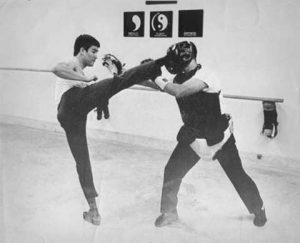JEET KUNE DO (JKD) is the personal combat philosophy of the late martial art legend, BRUCE LEE.

JKD training emphasizes the development of proficiency and a thorough understanding of the various ranges of combat in both empty-handed fighting and the use of weaponry.
The term Jeet Kune Do was coined in late 1966 during a drive-along conversation between Bruce Lee and his premier disciple Dan Inosanto.
They were discussing the idea of the “stop-hit”, a term used in Western Fencing to describe its most efficient means of countering. Instead of blocking and then countering, the idea in “stop-hitting” is to attack into the opponent’s attack. If/when the opponent suffers a lapse in attention or movement it offers an opportunity to “intercept” his attack. Therefore Jeet Kune Do is often translated as “The Way of the Intercepting Fist”.
YouTube Video of Bruce Lee explaining Jeet Kune Do
As you can see from the video, Jeet Kune Do takes its name from the concept of “intercepting”.
But we must explore Jeet Kune Do in order to develop an in-depth understanding of it.
Interception is part of the training guideline Bruce Lee called The Five Ways of Defence.
At Unified Martial Art (the school of Chip’s instructor, Dwight Woods) this training guideline has been renamed the The Five Ways of CounterOffence.
In descending order of efficiency and effectiveness, they are:
- Distance
- Block and Hit
- Simultaneous Parry and Hit
- Evade and Hit
- Stop-hit or Interception
Right from the start you must grasp the versatile approach to martial arts that is Jeet Kune Do. Before Bruce Lee, no one had determined that there was a finite number of skills that a well-rounded martial artist should develop. Bruce Lee referred to this concept as The Four Ranges of Combat.
At Unified Martial Art this has been “renamed” as The Four Skills of Empty-handed Combat since we’ve come to realise that many people mistake the word “range” to mean “distance from the opponent” and also that skill in weaponry is just as important as skill in empty hands.
- The Four Skills of Empty-handed Combat:
- Kicking (including the use of the shin & knee)
- Punching (including the use of the forearm & elbow)
- Trapping (limb immobilization)
- Grappling (throws, sweeps, takedowns, locks, chokes, submissions)
- • The Two Types of Weapons:
1. Non-edged weapons (any type of club)
2. Edged weapons (any type of blade)
Weapons training is broken down this way:
- The Two Types of Weapons:
- Non-edged weapons (any type of club)
- Edged weapons (any type of blade)
- Weapon Sub-types
- Flexible
- Throwing
- Projectile
- Weapon Sub-types
To round out all the types of training offered in empty-hands and weapons, the fundamental guiding principle is found in:
- The Three Combat Distances:
- Out of range
- (b)Rim of Fire
- In Range
A second fundamental guiding principle is found in:
- The Three Stages of Combat:
- Entry
- Follow-up/Mid-point
- Finish
But the conceptual approach to training and knowledge in Jeet Kune Do does not stop here.
As far as we know, just as Bruce Lee was the first to offer a tactical and strategic breakdown for skill development and a method of defence and/or counter-offence, he was also the first to “organise” the art of attack in a similar fashion.
This leads to the training guideline known as:
- The Five Ways of Attack
- Single Direct Attack (SDA) and its complement Single Angular Attack (SAA)
- Attack By Combination (ABC)
- Attack By Drawing (ABD)
- Hand/Foot Immobilisation Attack (H/FIA)
- Progressive Indirect Attack (PIA)
Before you make the (incorrect) conclusion that Jeet Kune Do is therefore an aggressive approach to combat, be assured that the misguided approach of aggressiveness is converted into the more beneficial approach of assertiveness, when we realise that in JKD there is actually much less direct attack than there is indirect attack.
In other words, instead of directly attacking someone our indirect attack is a response to their initial aggression towards us. “They start the fight but we end it!”
